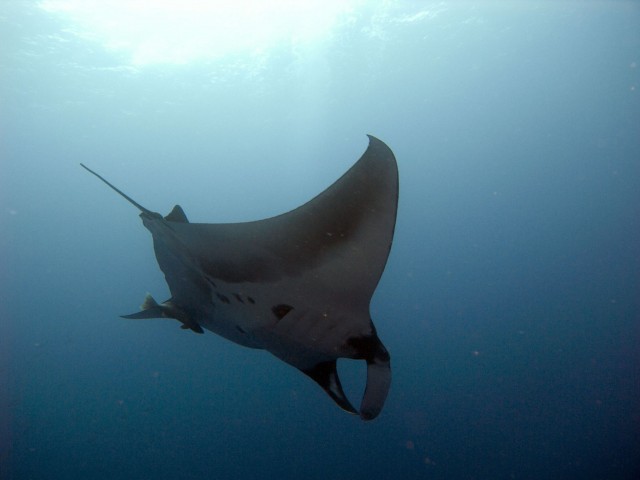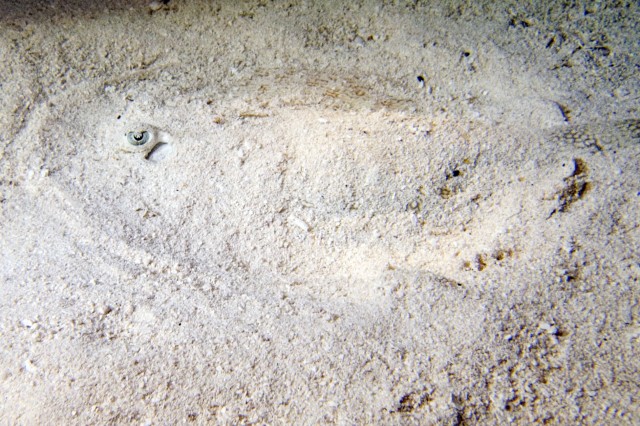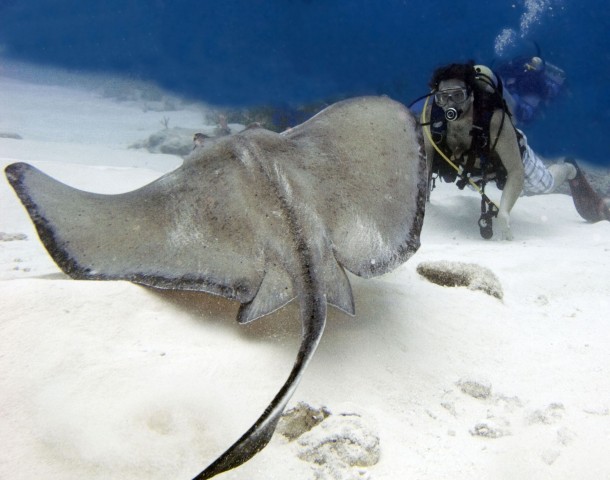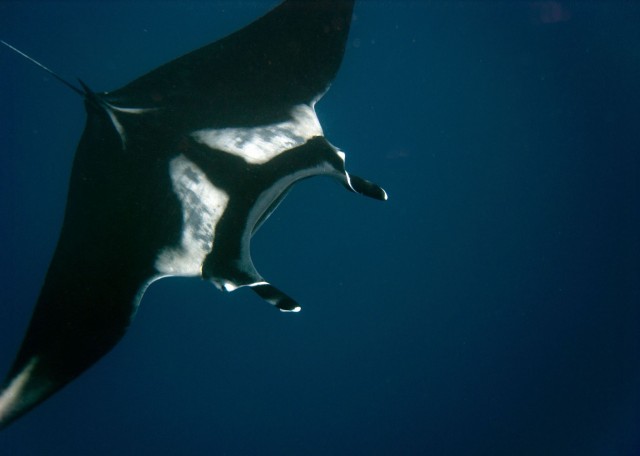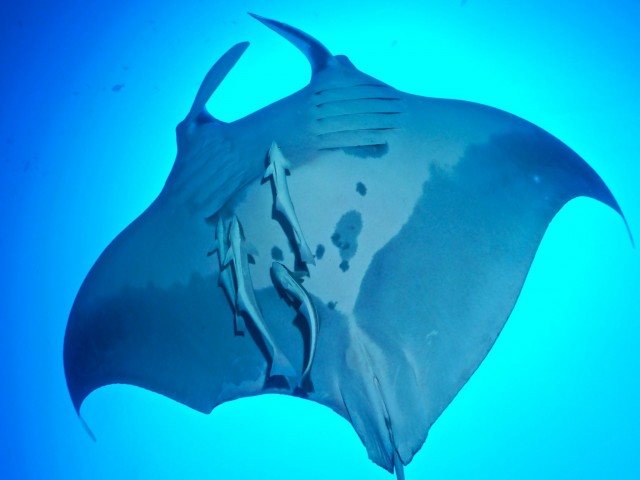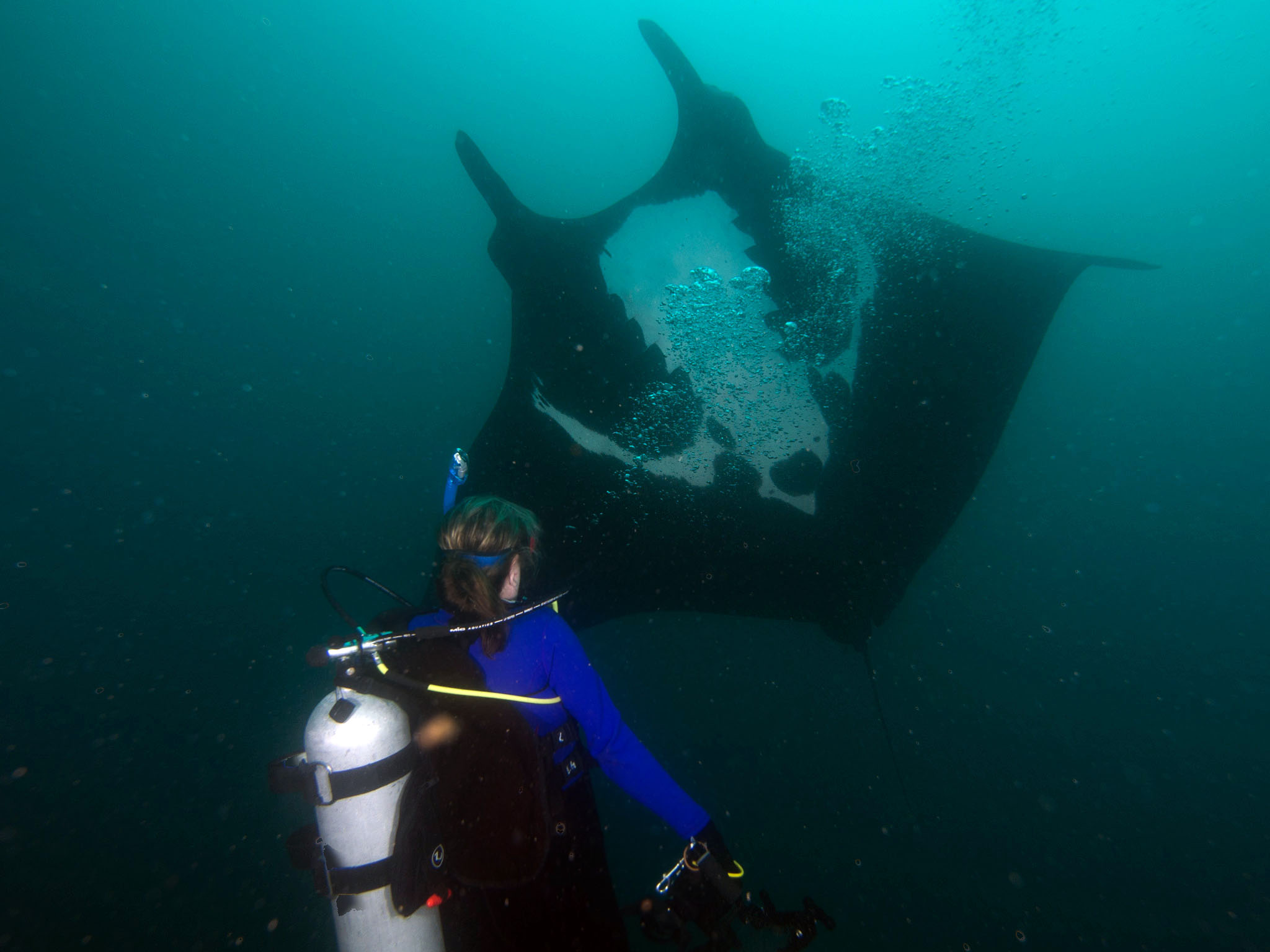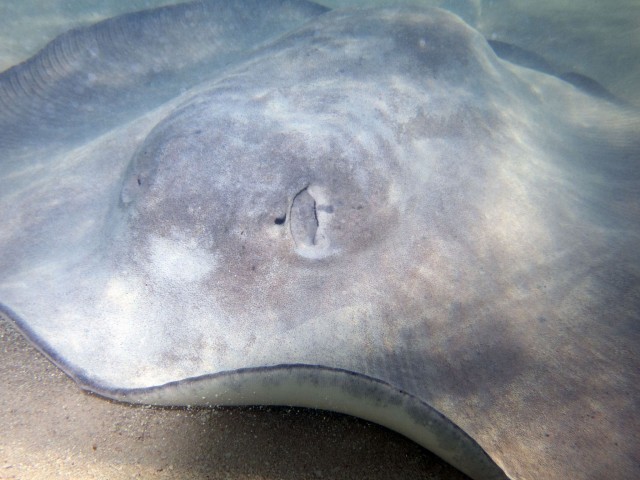Marine Life & Conservation Blogs
My Love of Rays
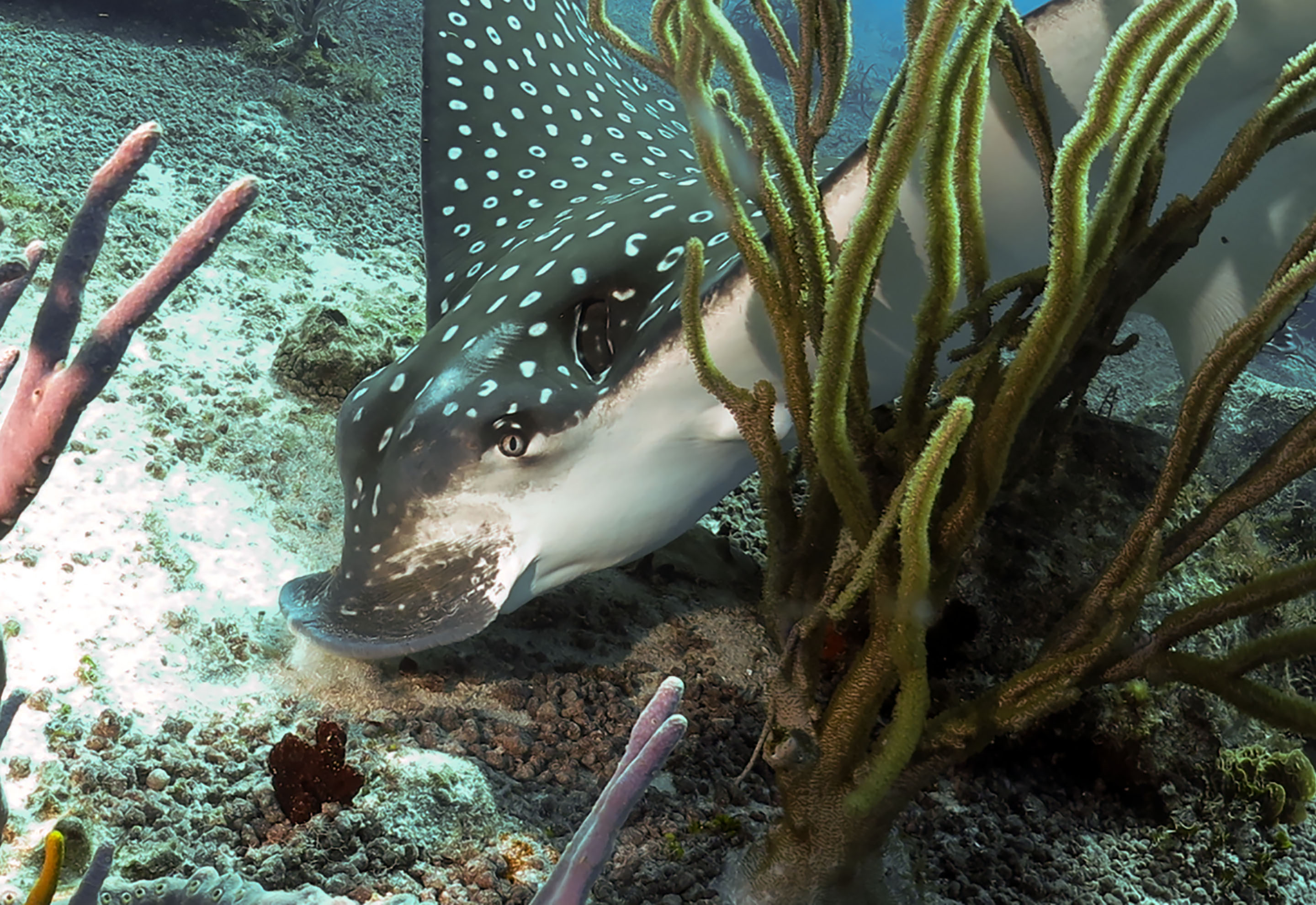
I love everything in the ocean. Really. But I do have to confess to a very special feeling for rays. Stingrays, Eagle Rays, Manta Rays… they are breathtaking to watch, and I get excited every single time I see one. My love of the ocean I credit to my parents, as they took my brother and I to Florida every year for at least two weeks during my childhood. My love of marine animals began with Jacques Cousteau, who introduced me, through his tv specials, to a mysterious underwater realm with incredible, colorful creatures. As a child, I watched spellbound. Sincerely, the ocean and its inhabitants make me happy, fill me with childlike wonder, and I can never, never get enough. I love to photograph them (even though I am strictly an amateur).
The first experience I ever had with rays was with Manta Rays. They were seen every summer off of Ft Lauderdale, Florida, and we were called out of the water immediately when they were sighted. I remember looking through the binoculars at a “devilfish” I found enthralling and graceful, though I was told they would “eat” me. As I began snorkeling and diving as a young adult, whenever a ray came near I was mesmerized. They fly through the water with graceful, undulating wings (flaps), and I have always found them beautiful. I love coming across them when they are buried in the sand, with just their eyes and spiracles visible. What a great photo that makes!
When our children were small, we took them to the Cayman Islands several times. Of course we went to Stingray City. I went to Stingray City when I was pregnant, both times actually, and snorkeled above my husband while he was covered in Southern Sting Rays. They feel so very soft, especially underneath. Like velvet. Stingray City was every bit as much for me as the kids; it always amazed me, to snorkel, float, or to stand near so many beautiful rays.
I saw my first Eagle Ray in Cozumel, and I was so excited I could barely breathe. Eagles are big and glorious as they fly through the water, and have “cheerios” markings. They all fascinate me, from the small Yellow Rays to the Southern Stingrays, to the Eagles, the blue spotted, and the Queen of them all, the Manta.
Seeing many new rays in Africa, I only saw two Mantas! Only two. Actually, my diving in Tofo was disappointing to me, but perhaps it was just the wrong season. For whatever reason, my visions of being surrounded by Manta Rays while diving did not materialize, at least not in Tofo. I did see Blue Spotted Rays, a Torpedo Electric Ray, one Mobula, a Jenkins Whiptail and a Honeycombed Whiptail, but I never saw the rare Small-Eye Stingray. I enjoyed seeing new and different rays, though.
My desire for Manta Ray encounters continued, and I finally achieved a dive trip where I saw several Giant Mantas, Black Pacific Mantas, Reef Mantas… it is almost indescribable, diving with these curious, beautiful, mysterious giants. You can tell from their eyes that they are intelligent; you know they are “checking” you out. I took a million photos, and each dive was more thrilling than the next… rays and sharks! What could be better? That was our trip on the Solmar V to the Revillagigedos Islands… I want to do that again! I turned my photos over to the Pacific Manta Research Group, and I photographed one they hadn’t seen in 10 years! They graciously allowed me to name it, so I named it Jedi. May the force be with you.
On Stocking Island in the Exumas, Bahamas, rays swarm the beach. AJ, the conch man, has been giving them scraps of conch for years and they gladly swim all over you in search of it! I loved feeding them, touching them, and taking pictures. One of the rays was different, definitely NOT a Southern Stingray as the rest of them were. It felt sandy on top, not soft, and had very small eyes with a large head and thick tail. I’d never seen it before. After a few days of research I found my ray: the Caribbean Whip Tail Ray! I had never even heard of it. I’m always excited when I see a new animal!
And the epitome of my Manta Ray diving so far has been a Citizen Science trip I went on with Marine Megafauna Ecuador. Hundreds of them! I was in heaven! It is essential that we help these creatures; Mantas are endangered. The Marine Megafauna Foundation works very hard, as do other great organizations, to change that. I urge you to take a look at their website and learn about these amazing creatures. I adopted a Manta and named her Daenarys Targareon, from Game of Thrones. Adopting a ray or a whale shark helps to protect these animals from extinction, and ending up in Chinese medicine and Shark Fin Soup. I urge you to visit them at www.marinemegafauna.org. You will fall in love! I certainly did.
For more from Tam, visit www.travelswithtam.com.
Blogs
Saba’s Plan for a Coral Comeback

Saba has an exciting new initiative to restore its coral reefs. This new project, running from 2024 to 2026, will focus on reviving key species in the island’s underwater ecosystems. With a collaborative team from the Saba Conservation Foundation (SCF) and Van Hall Larenstein (VHL) University of Applied Sciences, the project aims to restore both corals as well as sea urchins.
This initiative is centered around coral restoration, specifically reviving two essential coral species—staghorn coral (Acropora cervicornis) and elkhorn coral (Acropora palmata). By mapping parent colonies and using a technique known as coral gardening, SCF will create and maintain coral nurseries. These corals will eventually be outplanted at key reef sites around Saba to not only expand the number of coral colonies, but also provide essential fish habitat. The project focusses on installing coral nurseries, training staff with the newest techniques and starting with the restoration of key reef sites.

Reef Cleaners to the Rescue
It’s not just corals getting a makeover—this project also shines a spotlight on the essential role of grazers, particularly sea urchins. VHL is leading the charge on cultivating and restocking two key sea urchin species, West Indian sea egg (Tripneustes) and long-spined sea urchin (Diadema), known for their ability to keep algae in check. By removing algae, which are important competitors of corals, they help the coral to thrive. By restoring these “reef cleaners,” Saba’s project will give corals the breathing room they need to grow, setting the stage for a healthier, more balanced marine ecosystem.
From Tiny Urchins to Big Goals
The project will be funded as part of the Dutch Government’s Nature and Environment Policy Plan (NEPP) 2020-2030 for the Caribbean Netherlands, a comprehensive initiative aimed at conserving and restoring the unique natural environments of the Dutch Caribbean islands, including Saba, St. Eustatius, and Bonaire. This project is aiming for big milestones: build and maintaining coral nurseries, the expansion of urchin cultivation facilities, and the creation of a dedicated research center. By 2026, the project hopes to ramp up coral and grazer restoration, with the ultimate goal of extending these efforts across the Dutch Caribbean. By linking local initiatives to broader regional goals, Saba’s restoration project promises to leave a lasting impact on both the environment and the community.
Find out more about the DCNA at dcnanature.org.
Blogs
Reef-World marks two decades of marine conservation: strengthening impact amid coral reef threats

Empowering ocean stakeholders to tackle future challenges and ensure the survival of coral reefs and humanity
2024 marks the 20th Anniversary of The Reef-World Foundation’s tireless efforts for global coral reef conservation. The UK charity is the international coordinator of the UN Environment Programme’s Green Fins initiative, known as the leading voice in sustainable marine tourism. Today, Reef-World released its 2023-2024 Impact Report outlining a year of substantive growth and impact in its marine conservation programmes.

Impact Report Highlights:
- Impressive improvements in environmental behaviours to protect coral reefs by the marine tourism industry as the global participation of Green Fins increases.
- Continued capacity building for government and NGO staff to effectively manage marine tourism activities in Asia, Caribbean and Red Sea regions.
- For the first time in Green Fins’ 20-year history, tourism operators have achieved ‘Best Environmental Performer’ status by demonstrating the lowest possible environmental impact in their environmental assessments. In 2024, three dive operators achieved this challenging milestone.
- Significant increases in global participation of Reef-World’s innovative digital conservation tools.
- 138 Green Fins dive operator members achieved the strict threshold for PADI Eco Center recognition.
- Developed four new educational materials and translated two into 16 languages to support the marine tourism industry in achieving sustainability targets.
- Establishing a new Reef-World Development strategy and recruiting new roles – Development and Programmes Managers.
- Reef-World’s board welcomes new Chair and Trustees strengthening organisational leadership.

Reef-World started as a one-person mission to inspire and empower communities to act in conserving and sustainably developing coral reefs and related ecosystems. Today, the team of 12 continues to meet this mission by inspiring and empowering the global marine tourism community to be exemplary sustainability leaders by using the Green Fins guidelines and tools to simultaneously use and protect the world’s precious reefs.
In April 2024, the fourth global coral reef bleaching event was confirmed. Reef-World’s work has never been more urgent as the marine environment, and the benefits they provide humanity, continue to be eroded by global threats. The reduction of local threats, like those from the marine tourism industry, is an essential step to ensuring a future where coral reefs survive and continue to support the millions of people who depend on their ecosystem benefits. Reef-World’s work buys time for coral reefs and related ecosystems to be resilient to the impacts of global threats.
“Right now our corals are facing the greatest fight of their existence as the terrifying predictions of the steps towards their complete extinction are starting to come true. But all is not lost, reefs are resilient and they have existed on this planet for millions of years. We must take action now, to buy time for reefs by reducing threats facing them and allowing them to react and adjust to the changing environment they need to survive in.” – Chloe Harvey, Executive Director
Looking Forwards:
Like coral reefs, the Reef-World team needs to be resilient in the face of the complex challenges of the conservation sector. Reef-World has invested significantly in developing a Culture of Care to ensure the well-being of its team on a daily basis, continuing to be an exemplary employer to enable its team to best achieve the mission for coral reef conservation.
With the foundations of a Culture of Care and organisational development laid, Reef-World is emerging from the end of a natural organisation life cycle, that brings the challenges of growth and scale, stronger than ever. With a new strategy in place to generate much needed resources, Reef-World is excited for the opportunities to leap forward, continue to scale our impact and lean into new innovations and untapped opportunities for marine conservation.
We continually strive to become a forward-thinking organisation that delivers on our goals and commitments to our stakeholders with fresh approaches and not being afraid of steering away from a “normal approach.” This approach is not only applied to our programmes of work but also internally and carries over to our Culture of Care for our team.” — JJ Harvey, Operations Director

The Reef-World Foundation is immensely grateful for the continued support of its grant funders: UN Environment Programme, IUCN’s Blue Natural Capital Financing Facility, Adventure Travel Conservation Fund, PADI Aware Foundation, and World Nomads Footprints Program.
Reef-World would also like to express its gratitude to international partners whose vital support has resulted in significant tangible benefits for our work and mission: PADI; Professional SCUBA Schools International (PSS); Explorer Ventures; 1% for the Planet; ZuBlu; Snorkel Venture, GSTC; Dive O’Clock; Seven Dragons; DiveAssure and Eco Beach, without whom these achievements would not be possible.
The full 2023–2024 Annual Impact Report is available on Reef-World’s website.
-

 News2 months ago
News2 months agoIconic SS United States to become the World’s Largest Artificial Reef
-

 News3 months ago
News3 months agoBook Review – 52 Assignments: Underwater Photography
-

 Gear News3 months ago
Gear News3 months agoDYNAMICNORD – New German diving brand enters the British market
-

 News3 months ago
News3 months agoExploring Cenote El Pit: A Diver’s Dream
-

 Gear News3 months ago
Gear News3 months agoTry BARE drysuits (and maybe even win one!) this Friday with Sea & Sea at North West Dive Fest
-

 Marine Life & Conservation3 months ago
Marine Life & Conservation3 months agoBook Review: Coral Triangle Cameos
-

 Blogs2 months ago
Blogs2 months agoDive the Egyptian Red Sea this Autumn with Regaldive
-

 News3 months ago
News3 months ago2024 Ocean Art Underwater Photo Competition Announced


